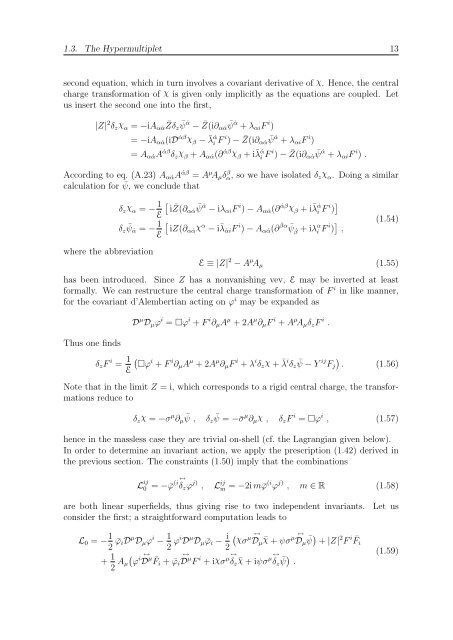N=2 Supersymmetric Gauge Theories with Nonpolynomial Interactions
N=2 Supersymmetric Gauge Theories with Nonpolynomial Interactions
N=2 Supersymmetric Gauge Theories with Nonpolynomial Interactions
You also want an ePaper? Increase the reach of your titles
YUMPU automatically turns print PDFs into web optimized ePapers that Google loves.
1.3. The Hypermultiplet 13<br />
second equation, which in turn involves a covariant derivative of χ. Hence, the central<br />
charge transformation of χ is given only implicitly as the equations are coupled. Let<br />
us insert the second one into the first,<br />
|Z| 2 δz χ α = −iAα ˙α ¯ Zδz ¯ ψ ˙α − ¯ Z(i∂α ˙α ¯ ψ ˙α + λαiF i )<br />
= −iAα ˙α(iD ˙αβχ β − ¯ λ ˙α i F i ) − ¯ Z(i∂α ˙α ¯ ψ ˙α + λαiF i )<br />
= Aα ˙αA ˙αβ δz χ β + Aα ˙α(∂ ˙αβχ β + i ¯ λ ˙α i F i ) − ¯ Z(i∂α ˙α ¯ ψ ˙α + λαiF i ) .<br />
According to eq. (A.23) Aα ˙αA ˙αβ = A µ Aµδ β α, so we have isolated δz χ α. Doing a similar<br />
calculation for ¯ ψ, we conclude that<br />
where the abbreviation<br />
δzχα = − 1 <br />
iZ(∂α ¯<br />
˙α<br />
E<br />
¯ ψ ˙α − iλαiF i ) − Aα ˙α(∂ ˙αβχβ + i¯ λ ˙α i F i ) <br />
δz ¯ ψ ˙α = − 1 <br />
iZ(∂α ˙α<br />
E<br />
χα − i¯ λ ˙αiF i ) − Aα ˙α(∂ ˙ βα<br />
ψ¯ β ˙ + iλ α i F i ) ,<br />
E ≡ |Z| 2 − A µ Aµ<br />
(1.54)<br />
(1.55)<br />
has been introduced. Since Z has a nonvanishing vev, E may be inverted at least<br />
formally. We can restructure the central charge transformation of F i in like manner,<br />
for the covariant d’Alembertian acting on ϕ i may be expanded as<br />
Thus one finds<br />
D µ Dµϕ i = ϕ i + F i ∂µA µ + 2A µ ∂µF i + A µ AµδzF i .<br />
δzF i = 1 i i<br />
ϕ + F ∂µA<br />
E<br />
µ + 2A µ ∂µF i + λ i δzχ + ¯ λ i δz ¯ ψ − Y ij <br />
Fj . (1.56)<br />
Note that in the limit Z = i, which corresponds to a rigid central charge, the transformations<br />
reduce to<br />
δz χ = −σ µ ∂µ ¯ ψ , δz ¯ ψ = −¯σ µ ∂µ χ , δzF i = ϕ i , (1.57)<br />
hence in the massless case they are trivial on-shell (cf. the Lagrangian given below).<br />
In order to determine an invariant action, we apply the prescription (1.42) derived in<br />
the previous section. The constraints (1.50) imply that the combinations<br />
L ij<br />
↔<br />
(i<br />
0 = − ¯ϕ δzϕ j) , L ij m = −2i m ¯ϕ (i ϕ j) , m ∈ R (1.58)<br />
are both linear superfields, thus giving rise to two independent invariants. Let us<br />
consider the first; a straightforward computation leads to<br />
L0 = − 1<br />
2 ¯ϕiD µ Dµϕ i − 1<br />
2 ϕiD µ Dµ ¯ϕi − i ↔<br />
χσ<br />
µ<br />
Dµ<br />
2<br />
¯χ ↔<br />
µ<br />
+ ψσ Dµ ¯ ψ + |Z| 2 F i Fi<br />
¯<br />
+ 1<br />
2 Aµ<br />
i<br />
ϕ ↔<br />
D µ ↔<br />
Fi<br />
¯ + ¯ϕi D µ F i ↔<br />
µ<br />
+ iχσ δz ¯χ ↔<br />
µ<br />
+ iψσ δz ¯ ψ .<br />
(1.59)

















